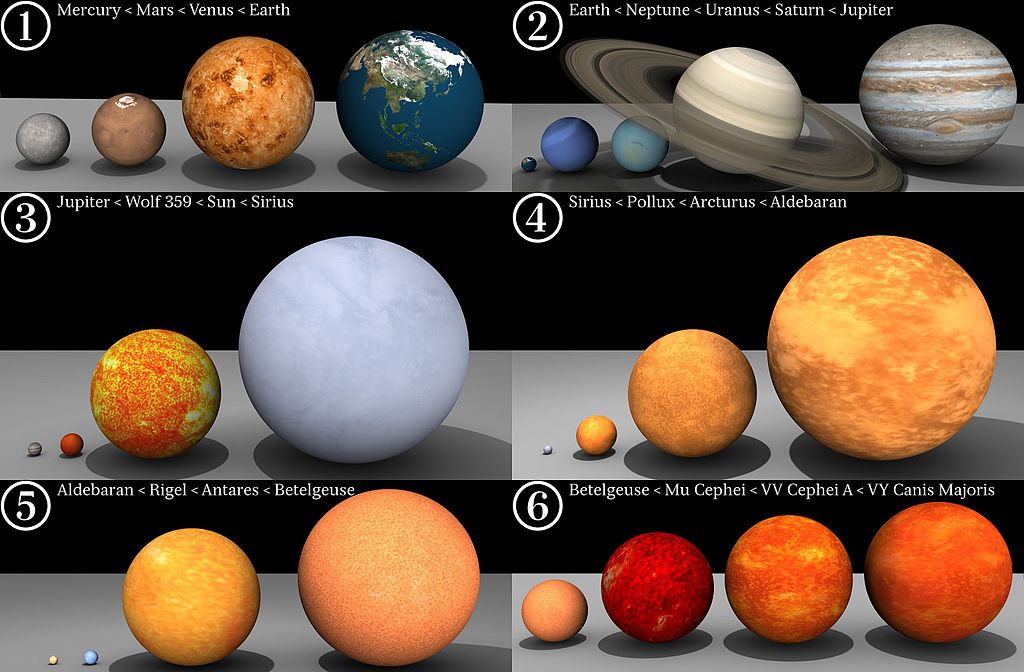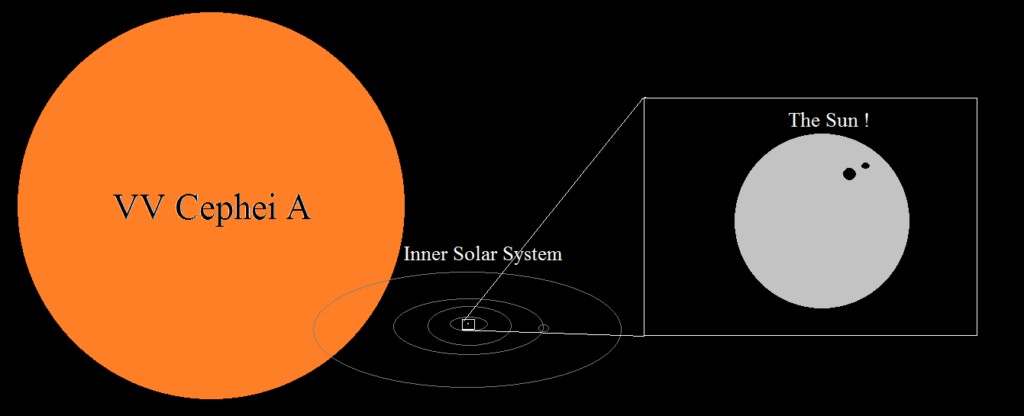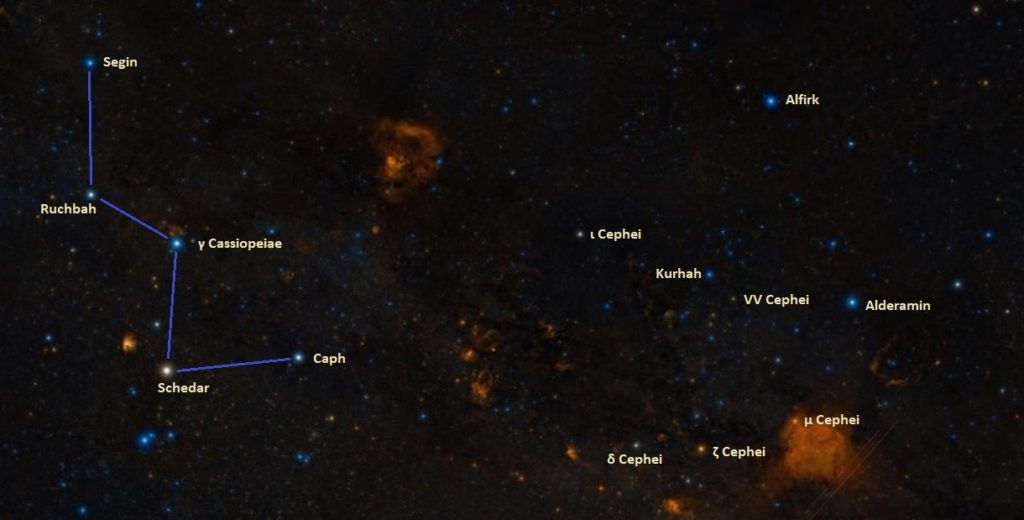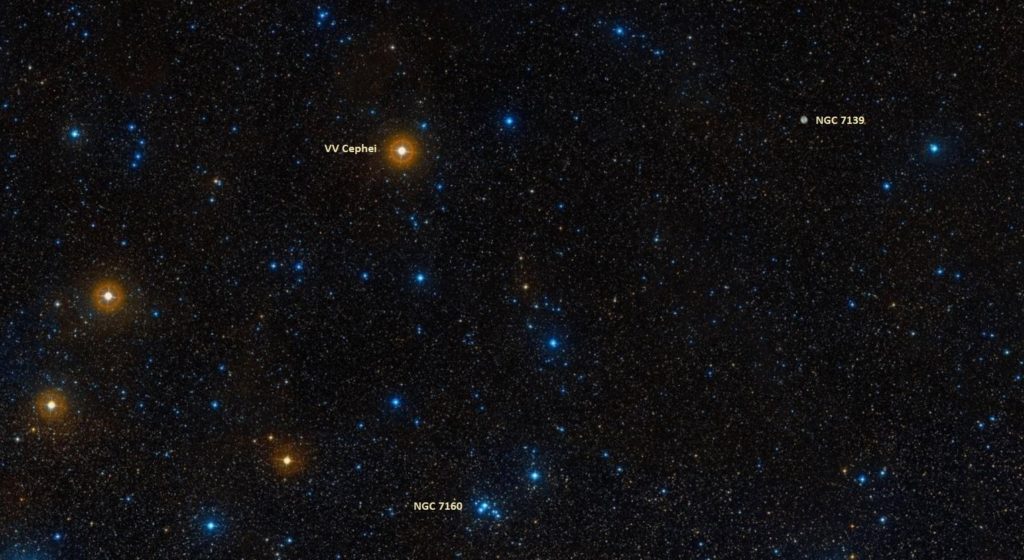VV Cephei is an eclipsing binary star system located approximately 4,900 light years from Earth in the constellation Cepheus. It has an apparent magnitude of 4.91. The primary star in the system, VV Cephei A, is one of the largest known stars in the Milky Way. Even though its exact size is uncertain, the red supergiant is believed to have a radius between 1,050 and 1,900 times that of the Sun.
Star system
VV Cephei consists of two stars, a cool red supergiant of the spectral type M2 Iab and a hot blue-white main sequence star with the stellar classification B0-2 V. The two stars orbit each other with a period of 7,430.5 days (20.35 years). The supergiant dominates the visual and infrared wavelengths and the companion is more prominent in the ultraviolet part of the spectrum. In the visual band, the system’s brightness varies from magnitude 4.9 to 5.4.
As the stars orbit each other, the primary component fills its Roche lobe (the region around the star within which material is gravitationally bound to it) when it is the closest to the main sequence star, and the material is transferred onto the companion. As a result, the companion is shrouded by a disk of material, which causes the primary eclipses. These last for about 650 days and leave much of the blue light from the main sequence star blocked, causing the system’s brightness to drop. The secondary eclipses occur when the companion obscures a very small portion of the large supergiant star. However, these are very shallow and have not been detected photometrically.
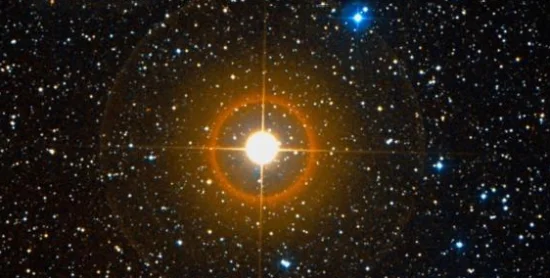
VV Cephei, image: Wikisky
The disk of material around the companion, seen almost edge-on, produces emission lines, including forbidden spectral lines of iron(II), copper(II), and nickel(II), and the star is classified both as a B[e] star and shell star.
VV Cephei is classified as an Algol-type variable and semiregular variable of the type SRc, indicating an amplitude of about 1 magnitude and variability period from 30 days to several thousand days. The system’s brightness varies semiregularly by a few tenths of a magnitude. Observations at ultraviolet wavelengths have also revealed variations over a period of 58 days that do not seem related to the variations detected in the visual and infrared parts of the spectrum. At longer wavelengths, the most prominent variations have a period of 118.5 days. The changes in brightness detected in short wavelengths are believed to be due to the disk of material obscuring the companion, while other variations are caused by the pulsation of the primary component.
VV Cephei has the second longest known period of all eclipsing binary stars. The only system with a longer period is Epsilon Aurigae (Almaaz) with a period of 9,890 days or 27.1 years.
VV Cephei A
The red supergiant, designated VV Cephei A, has an estimated radius between 1,050 and 1,900 times that of the Sun. If it took the Sun’s place in our solar system, its photosphere would stretch beyond the orbit of Jupiter and possibly come close to that of Saturn. The star’s mass is uncertain, with measurements yielding values of 2.5 as well as 18.2 solar masses. With an effective temperature of 3,826 K, VV Cephei A is about 200,000 times more luminous than the Sun.
The exact mass and size of VV Cephei A are difficult to determine and different measurements have yielded different values. In 1971, Hutchings and Wright gave 18.3 solar masses. In 1977, Wright gave 19.7 solar masses and a radius 1,600 times that of the Sun. In 1981, Möllenhoff and Schaifers gave 20 solar masses and 1,800 solar radii. In 1999, Grascyk, Mikolajewsi, and Janowski gave 2.5 solar masses and, in 2007, Bennet found a radius 1,015 times solar.
The factors that make it difficult to calculate the masses of both VV Cephei A and B include mass loss from the supergiant, the disk of material hiding the secondary component, uncertainty about the distance, and changes in the orbital elements. Additionally, with 20.35 years passing between eclipses, there are few opportunities to collect quality data. If the higher estimates of the star’s mass are correct, the primary component will end its life as a supernova in the not-too-distant future (astronomically speaking), possibly sending the companion into space.
Using the spectroscopically derived orbit and the traditional model puts the masses of both components at about 20 solar masses, which is in line with expected values for a red supergiant and a white, class A main sequence star. The second model, based on an eclipse observed in 1997, proposed that the change in the orbit and the unpredicted timing of the eclipse were the result of mass transfer and that, consequently, both stars were considerably less massive. The model suggested that the primary component was a star on the asymptotic giant branch with 2.5 solar masses and the companion a class B star with 8 solar masses.
The temperature of the two components is also difficult to determine. VV Cephei A is a non-spherical star, highly distorted by the gravity of the close companion. It does not have a single temperature because some parts of its surface are closer to the centre of mass than others. The temperature of about 3,800 K is given based on the star’s spectral class (M2 supergiant). The companion is hidden by a disk of material and, while its spectral class is early B and the star is still on the main sequence, the mass transfer from the primary component likely makes it abnormal in several ways.
Size
The direct calculation of the radius of VV Cephei A using the angular diameter of 0.00638 arcseconds yields a size of 1,050 solar radii, which is close to the orbit of Jupiter. This means that the star is larger than such behemoths as Betelgeuse (887 R☉), NR Vulpeculae (980 R☉), S Cassiopeiae (930 R☉), and likely KW Sagittarii (1,009 – 1,460 R☉) and RW Cephei (981 – 1,758 R☉), but probably not quite the size of VX Sagittarii (1,120 – 1,550 R☉), MY Cephei (1,134 R☉), NML Cygni (1,183 R☉), Mu Cephei (1,260 – 1,650 R☉), VY Canis Majoris (1,420 R☉), and the current record holders WOH G64 (1,540 – 2,575 R☉) and Westerlund 1-26 (1,530 – 1,580 R☉). The higher estimates, up to 1,900 solar radii, put the star near the orbit of Saturn and make it a candidate for the largest star known.
VV Cephei vs. Sun
Based on current data, VV Cephei A is at least 1,050 times larger than the Sun. If placed at the centre of the solar system, the star would extend to the orbit of Jupiter and possibly beyond.
VV Cephei vs. UY Scuti
UY Scuti was believed to be the largest star known with a radius 1,708 times that of the Sun until direct measurements of its parallax (Gaia Data Release 2) showed that it was much closer to us and consequently much smaller and less luminous. The currently (2020) accepted radius for UY Scuti is 755 solar radii, which means that the former record holder is in fact much smaller than VV Cephei.
VV Cephei B
The companion, VV Cephei B, has a mass of either 8 or 18.6 solar masses and a radius between 13 and 25 times that of the Sun. Its estimated age is about 25 million years.
The size and mass of VV Cephei B have been just as challenging to pin down as those of the primary, mainly because it is obscured by a disk of material with a radius several hundred times that of the Sun. In 1971, Hutchings and Wright gave 19.8 solar masses. In 1977, Wright measured 20 solar masses (same as the supergiant) and a radius 13 times that of the Sun, with the accretion region of 650 solar radii. In 1992, Hack et al. gave 25 solar radii and, in 1999, Grascyk, Mikolajewsi, and Janowski gave 8 solar masses.
As the star is surrounded by a disk of material, its spectrum is never seen directly, making the spectral class difficult to determine, but it is believed to be early B.
Facts
American astronomer Dean B. McLaughlin was the first to discover that VV Cephei was an eclipsing binary system in 1936. The star’s variability and spectral peculiarities were discovered by the American astronomer Annie Jump Cannon about 30 years earlier.
In 1936, Russian astronomer Sergei Gaposchkin studied historical data and found the long-period eclipsing nature of the system. With eclipses recorded in 1896, 1916 and 1936, Gaposchkin found an interval of 7,430 days, an eclipse depth of 0.8 magnitudes in the photographic data and only 0.1 in visual light, and an eclipse duration of 490 days.
In 1954, American astronomer William P. Bidelman defined VV Cephei stars as a class in his “Catalogue and Bibliography of Emission-Line Stars of Types Later than B.” This was a group of supergiant binary systems with bright hydrogen lines and emission lines of iron(II) in their spectra. VV Cephei was the only known eclipsing binary star system in the group, which also included W Cephei, KN Cassiopeiae, WY Geminorum, KQ Puppis, WY Velorum, and V381 Cephei.
Without the interstellar extinction of 1.24 magnitudes, VV Cephei would appear much brighter. However, the star lies at a great distance and the dimming effect of interstellar dust is considerable.
Location
With an apparent magnitude of 4.91, VV Cephei is difficult to find without binoculars. It is located in the area between Alderamin, the brightest star in Cepheus, and Cassiopeia’s distinct W asterism. Alderamin lies on the imaginary line extended from Schedar through Caph, the stars on the right side of the W, and VV Cephei is located roughly in the area between Alderamin and the magnitude 4.2 Xi Cephei (Kurhah).
Due to its far northern location, VV Cephei is circumpolar, i.e. visible throughout the year, from the northern hemisphere. However, it requires exceptionally clear, dark skies to be spotted without binoculars.
VV Cephei lies in the vicinity of two relatively bright deep sky objects: the magnitude 6.1 open cluster NGC 7160, which lies a degree to the south-southwest of the star, and the magnitude 13 planetary nebula NGC 7139, visible in 6-inch and larger telescopes in good conditions.
Constellation
VV Cephei is located in the constellation Cepheus. Stretching across 588 degrees of the northern sky between Cassiopeia, Cygnus, Draco, Ursa Minor, Lacerta and Camelopardalis, Cepheus is one of the Greek constellations, first catalogued by Ptolemy of Alexandria in the 2nd century CE. It represents the mythical King Cepheus, father of Andromeda and husband of Cassiopeia.
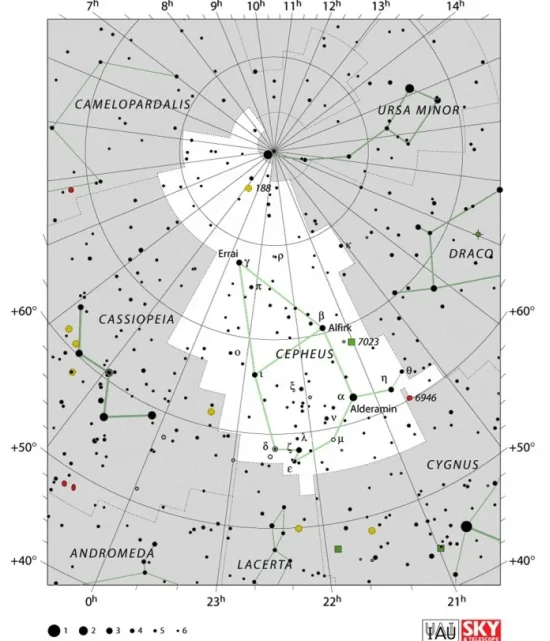
Cepheus constellation map by IAU and Sky&Telescope magazine
Cepheus is home to a number of interesting stars, including Delta Cephei and Beta Cephei (Alfirk), both prototypes for their own classes of variable stars, and the semiregular variable Mu Cephei (Garnet Star), one of the largest stars known. Alfirk and several other Cepheus stars – Alderamin (Alpha Cephei), Errai (Gamma Cephei), and Iota Cephei – hold the title of North Star during the Earth’s precession cycle, coming within 5 degrees or less of the north celestial pole.
Notable deep sky objects in the constellation include the spiral galaxy NGC 6946, also known as the Fireworks Galaxy, the diffuse nebula Sharpless 155 (the Cave Nebula), the reflection nebulae NGC 7023 (the Iris Nebula) and the Ghost Nebula (Sh2-136), the planetary nebula NGC 40 (the Bow-Tie Nebula), and the star cluster NGC 188, the nearest open cluster to the north celestial pole.
The best time of year to observe the stars and deep sky objects in Cepheus is during the month of November.
The 10 brightest stars in Cepheus are Alderamin (Alpha Cep, mag. 2.5141), Errai (Gamma Cep, mag. 3.21), Alfirk (Beta Cep, mag. 3.23), Zeta Cephei (mag. 3.35), Eta Cephei (mag. 3.426), Iota Cephei (mag. 3.507), Delta Cephei A (mag. 4.07), Epsilon Cephei (mag. 4.18), Theta Cephei (mag. 4.22), and Mu Cephei (4.23).
VV Cephei
| Spectral class | M2 Iab + B0-2 V |
| Variable type | Algol, semiregular variable (SRc) |
| U-B colour index | +0.43 |
| B-V colour index | +1.73 |
| Apparent magnitude | 4.91 (4.9 – 5.4) |
| Absolute magnitude | -6.93 |
| Distance | 4,900 light years (1,500 parsecs) |
| Parallax | 1.33 ± 0.20 mas |
| Radial velocity | -18.7 km/s |
| Proper motion | RA: -0.25 mas/yr |
| Dec.: -2.56 mas/yr | |
| Constellation | Cepheus |
| Right ascension | 21h 56m 39.14385s |
| Declination | +63° 37′ 32.0174″ |
| Designations | VV Cephei, HD 208816, HR 8383, HIP 108317, BD+62°2007, AAVSO 2153+63, SAO 19753, FK5 3756, GC 30731, GCRV 13794, PPM 23328, WDS J21567+6338, IRAS 21552+6323, 2MASS J21563917+6337319, CCDM J21567+6338AB, TYC 4266-3252-1, Gaia DR2 2216536246703152256 |
VV Cephei A
| Spectral class | M2 Iab |
| U-B colour index | +2.07 |
| B-V colour index | +1.82 |
| Mass | 2.5 or 18.2 M☉ |
| Luminosity | 200,000 L☉ |
| Radius | 1,400 R☉, 1,050 – 1,900 R☉ |
| Temperature | 3,826 K |
| Metallicity | -0.06 dex |
| Surface gravity | 0.0 cgs |
VV Cephei B
| Spectral class | B0-2 V |
| U-B colour index | −0.52 |
| B-V colour index | +0.36 |
| Mass | 8 or 18.6 M☉ |
| Radius | 13 – 25 R☉ |
| Metallicity | -0.14 |
| Age | 25 million years |
